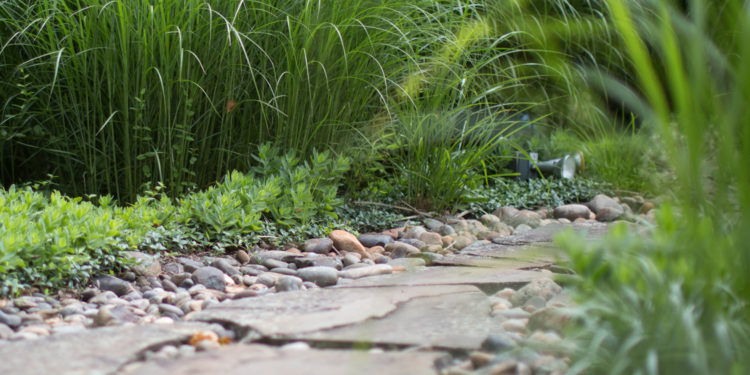Glossary of Eco-Friendly and Sustainable Landscaping Terms and Terminology
We used many of these terms in our Environmentally Friendly Landscaping article. Read on for more detailed explanations of each concept.
Eco-Friendly / Sustainable Landscaping
Landscaping that involves planting native plants that will thrive in their local soil type. These plants generally require less watering, and use no synthetic fertilziers or pesticides. This also restores native plants to their rightful areas, and creates healthy habitats for local wildlife.
Xeriscaping
The practice of designing landscapes to reduce or eliminate the need for irrigation. This means xeriscaped landscapes need little or no water beyond what the natural climate provides. Xeriscaping often means replacing grassy lawns with soil, rocks, mulch, and drought-tolerant native plant species. In desert areas like Phoenix, AZ, xeriscaping can include beautiful native shrubs like the ocotillo.
Native Plants / Grasses / Species
A native plant species is one “that occurs naturally in a particular region, state, ecosystem, and habitat without direct or indirect human actions” according to the Federal Native Plant Conservation Committee.
Bee Friendly Pollinator Plants
While there are many, here is a short list of flowers that bees love: Alyssum, Agastache (anise hyssop), Asclepias (butterfly weed), Aster, Echinacea (coneflower), Geranium (cranesbill), Monarda (bee balm), Papaver (poppies), Rudbeckia (black-eyed Susan), and Trifolium (clover).
Rainscaping
Any combination of plantings, water features, catch basins, permeable pavement and other activities that manage stormwater as close as possible to where it falls, rather than moving it someplace else. In addition to rain gardens and bioswales, a diverse landscape that includes trees, shrubs, perennials, mulch, and amended soils that intercept and disperse rain as it falls, and allows more water absorption into the soil and by plants.
CSA Subscription
Community Supported Agriculture (CSA) consists of a community of individuals who pledge support to a farm operation. By paying in advance for a seasonal subscription, farms are able to better plan, employ, and plant seeds for the entire growing season.
Biological Permaculture
The philosophy of working with, rather than against nature. Thoughtful observation rather than thoughtless labor. Looking at plants and animals in all their functions, rather than treating any area as a single product system.
Goat Weed Management
Goats will eat almost any vegetation and have a capacity to digest even plants with stickers and thorns. They do require variety in their diet, so farmers are careful to rotate them through crop rotation.
No-Till Seeding
No-till farming (also known as zero tillage or direct drilling) is an agricultural technique for growing crops or pasture without disturbing the soil through tillage. No-till farming decreases the amount of soil erosion tillage causes in certain soils, especially in sandy and dry soils on sloping terrain.
Companion Planting
Companion planting is when two plants are grown close together for the benefit of one or both of those plants (the benefit could go one way or be mutual). This can be growing nectar-rich flowers among crops to attract pollinators, or two vegetables grown side by side to confuse or repel pests.
Regenerative agriculture
According to non-profit Farmer’s Footprint, regenerative agriculture focuses on rebuilding organic matter and living biodiversity in soil, which produces increasingly nutrient-dense food year after year—while rapidly sequestering excess atmospheric carbon underground to reverse climate change. Regenerative agricultural practices include: no tillage, diverse cover crops, in-farm fertility, compost, holistic planned grazing, no pesticides or synthetic fertilizers, multiple crop rotations, biochar, and pollinator “highways.” Together, these practices increase carbon-rich soil organic matter. The result: vital microbes proliferate, roots go deeper, nutrient uptake improves, water retention increases, plants are more pest resistant, and soil fertility compounds.
Biodynamic Agriculture
There are six principles of biodynamic agriculture: plant diversity, crop rotation, animal rotation grazing, composting, homeopathic solutions, and life forces.
1. Plant Diversity
A method of keeping soil healthy by allowing a variety of plants to grow on uncultivated land—enhanced by mixing crops so plants work in support of each other (if one plant depletes a certain nutrient in the soil, a companion plant releases that same nutrient into the soil).
2. + 3. Crop Rotation + Animal Rotation Grazing
The practice of rotating crops from field to field and raising varied animal species, along with cover crops and green manures, encourages healthy soil, reduces parasites and controls weeds and pests.
4. Composting
Recycling food and other organic waste into compost provides a range of environmental benefits, including improving soil health, reducing greenhouse gas emissions, recycling nutrients, and mitigating the impact of droughts. In larger farms, recycled manures and organic waste in the compost pile create humus vital to the farm. When spread on fields, the humus stabilizes nitrogen in the soil, vital to crop productivity.
5. Homeopathic Solutions
According to the website HowStuffWorks.com, there are nine homeopathic preparations based on extracts from animal, plant, and mineral
manure, each diluted into sprays and used sparingly to homeopathically treat compost, soil, and plants in a process called dynamization. Each preparation is
numbered, 500 through 508—six are key to composting, two are used to stimulate humus and one is used to suppress fungal disease on crops.
6. Life Force
The principle of life force separates biodynamic farming from other agriculture because it’s the acknowledgement that in addition to earthly influences (biology, physics, chemistry), cosmic forces (moon phases, celestial and seasonal cycles) play a role in the life of the farm.
–This glossary will be updated regularly. To have something added or make a correction, email us here.
Continue to follow along for more Nest Magazine in Motion content, videos, tips, tricks, interior design and landscaping advice, and expert real estate features and stories.
